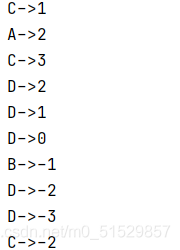前言
生产者,消费者模型无论是平常开发中,还是面试中都是很经常用到的,它是通过一个容器来解决生产者和消费者的强耦合问题,生产者和消费者彼此之间不直接通讯,而通过阻塞队列来进行通讯,所以生产者生产完数据之后不同等待消费者处理,直接扔给阻塞队列,消费者不找生产者要数据,而是直接从阻塞队列里获取,阻塞队列就相当于一个缓冲区,平衡了生产者和消费者的处理能力,这个阻塞队列就是用来给生产者和消费者解耦的
一、阻塞队列
- 阻塞队列就如同队列,先进先出
- 阻塞:表示这个队列是线程安全的
- 当队列满的时候往里面插入元素,此时会阻塞,一直阻塞到队列不满的时候才会完成插入
- 当对列为空的时候,从队列中取元素,此时也会阻塞,一直到队列不为空时,才能完成去元素操作
下面来康康代码如何实现的吧
public static void main(String[] args) throws InterruptedException {
BlockingDeque<String> deque = new LinkedBlockingDeque<>(3);
deque.put("a");
deque.put("b");
deque.put("c");
//它的初始容量只有3,当我们放进去第四个的时候会出现什么样的效果?
deque.put("d");
}
}
结果就是一直处于阻塞状态直到可以放了

public static void main(String[] args) throws InterruptedException {
BlockingDeque<String> deque = new LinkedBlockingDeque<>(3);
deque.put("a");
deque.put("b");
deque.put("c");
//它的初始容量只有3,当我们放进去第四个的时候会出现什么样的效果?
// deque.put("d");
System.out.println(deque.take());
System.out.println(deque.take());
System.out.println(deque.take());
System.out.println(deque.take());
// System.out.println(deque.take());
}
}
同样的当我们只有三个,想要取更多的时候就会发生阻塞

传统的生产者、消费者问题
/**
* A B操作同一变量,num
* A+1,B-1 保证AB之间通信
*/
public class A {
public static void main(String[] args) {
Data data = new Data();
new Thread(() -> {
for (int i = 0; i < 5; i++) {
try {
data.increment();
} catch (InterruptedException e) {
e.printStackTrace();
}
}
}, "A").start();
new Thread(() -> {
for (int i = 0; i < 5; i++) {
try {
data.decrement();
} catch (InterruptedException e) {
e.printStackTrace();
}
}
}, "B").start();
}
}
class Data {
private int num = 0;
//+1
public synchronized void increment() throws InterruptedException {
if (num != 0) {
//等待
this.wait();
}
num++;
System.out.println(Thread.currentThread().getName() + "->" + num);
//通知其他线程
this.notifyAll();
}
//-1
public synchronized void decrement() throws InterruptedException {
if (num == 0) {
//等待
this.wait();
}
num--;
System.out.println(Thread.currentThread().getName() + "->" + num);
//通知
this.notifyAll();
}
}
- 如果多个线程 A B C D
public static void main(String[] args) {
Data data = new Data();
new Thread(() -> {
for (int i = 0; i < 5; i++) {
try {
data.increment();
} catch (InterruptedException e) {
e.printStackTrace();
}
}
}, "A").start();
new Thread(() -> {
for (int i = 0; i < 5; i++) {
try {
data.decrement();
} catch (InterruptedException e) {
e.printStackTrace();
}
}
}, "B").start();
new Thread(() -> {
for (int i = 0; i < 5; i++) {
try {
data.increment();
} catch (InterruptedException e) {
e.printStackTrace();
}
}
}, "C").start();
new Thread(() -> {
for (int i = 0; i < 5; i++) {
try {
data.decrement();
} catch (InterruptedException e) {
e.printStackTrace();
}
}
}, "D").start();
}
}
class Data {
private int num = 0;
//+1
public synchronized void increment() throws InterruptedException {
if (num != 0) {
//等待
this.wait();
}
num++;
System.out.println(Thread.currentThread().getName() + "->" + num);
//通知其他线程
this.notifyAll();
}
//-1
public synchronized void decrement() throws InterruptedException {
if (num == 0) {
//等待
this.wait();
}
num--;
System.out.println(Thread.currentThread().getName() + "->" + num);
//通知
this.notifyAll();
}
}
出现了异常情况

- 防止虚假唤醒 :线程可以被唤醒,而不会接到通知,中断或超时
- 等待总是出现在循环中,上面用if判断可能会造成虚假唤醒 下面是防止虚假唤醒的
public static void main(String[] args) {
Data data = new Data();
new Thread(() -> {
for (int i = 0; i < 5; i++) {
try {
data.increment();
} catch (InterruptedException e) {
e.printStackTrace();
}
}
}, "A").start();
new Thread(() -> {
for (int i = 0; i < 5; i++) {
try {
data.decrement();
} catch (InterruptedException e) {
e.printStackTrace();
}
}
}, "B").start();
new Thread(() -> {
for (int i = 0; i < 5; i++) {
try {
data.increment();
} catch (InterruptedException e) {
e.printStackTrace();
}
}
}, "C").start();
new Thread(() -> {
for (int i = 0; i < 5; i++) {
try {
data.decrement();
} catch (InterruptedException e) {
e.printStackTrace();
}
}
}, "D").start();
}
}
class Data {
private int num = 0;
//+1
public synchronized void increment() throws InterruptedException {
while (num != 0) {
//等待
this.wait();
}
num++;
System.out.println(Thread.currentThread().getName() + "->" + num);
//通知其他线程
this.notifyAll();
}
//-1
public synchronized void decrement() throws InterruptedException {
while (num == 0) {
//等待
this.wait();
}
num--;
System.out.println(Thread.currentThread().getName() + "->" + num);
//通知
this.notifyAll();
}
}
JUC版的生产者消费者问题
public class B {
public static void main(String[] args) {
Data2 data = new Data2();
new Thread(() -> {
for (int i = 0; i < 5; i++) {
try {
data.increment();
} catch (InterruptedException e) {
e.printStackTrace();
}
}
}, "A").start();
new Thread(() -> {
for (int i = 0; i < 5; i++) {
try {
data.decrement();
} catch (InterruptedException e) {
e.printStackTrace();
}
}
}, "B").start();
new Thread(() -> {
for (int i = 0; i < 5; i++) {
try {
data.increment();
} catch (InterruptedException e) {
e.printStackTrace();
}
}
}, "C").start();
new Thread(() -> {
for (int i = 0; i < 5; i++) {
try {
data.decrement();
} catch (InterruptedException e) {
e.printStackTrace();
}
}
}, "D").start();
}
}
class Data2 {
private int num = 0;
Lock lock = new ReentrantLock();
Condition condition = lock.newCondition();
//+1
public void increment() throws InterruptedException {
lock.lock();
try {
while (num != 0) {//0
//等待
condition.await();
}
num++;
System.out.println(Thread.currentThread().getName() + "->" + num);
//通知其他线程
condition.signalAll();
}catch (Exception e ){
e.printStackTrace();
}finally {
lock.unlock();
}
}
//-1
public synchronized void decrement() throws InterruptedException {
lock.lock();
try {
while (num == 0) {//1
//等待
condition.await();
}
num--;
System.out.println(Thread.currentThread().getName() + "->" + num);
//通知
condition.signalAll();
}catch (Exception e ){
e.printStackTrace();
}finally {
lock.unlock();
}
}
}
-上面代码使用lock 中的await()和signalAll() 来实现线程之间相互通信
-但是还有个问题 这个代码每次运行结果都不一样,我们怎么能让A执行完执行B,B执行完执行C呢,那么就要用到精准通知signal()
/**
* A->B->C A执行完调用B B执行完调用C C执行完调用A 精准通知唤醒
*/
public class C {
public static void main(String[] args) {
Data3 data3 = new Data3();
new Thread(()->{
for (int i = 0; i <10 ; i++) {
data3.PrintA();
}
},"A").start();
new Thread(()->{ for (int i = 0; i <10 ; i++) {
data3.PrintB();
}},"B").start();
new Thread(()->{ for (int i = 0; i <10 ; i++) {
data3.PrintC();
}},"C").start();
}
}
class Data3{
private Lock lock = new ReentrantLock();
private Condition condition1 = lock.newCondition();
private Condition condition2 = lock.newCondition();
private Condition condition3 = lock.newCondition();
private int num =1; //1时A执行 2时B执行 3时C执行
public void PrintA(){
lock.lock();
try{
while (num!=1){
condition1.await();
}
System.out.println(Thread.currentThread().getName()+"----A");
//唤醒B
condition2.signal();
num=2;
}catch (Exception e){
e.printStackTrace();
}finally {
lock.unlock();
}
}
public void PrintB(){
lock.lock();
try {
while (num!=2){
condition2.await();
}
System.out.println(Thread.currentThread().getName()+"----B");
num=3;
condition3.signal();
}catch (Exception e){
e.printStackTrace();
}finally {
lock.unlock();
}
}
public void PrintC(){
lock.lock();
try {
while (num!=3){
condition3.await();
}
System.out.println(Thread.currentThread().getName()+"----C");
num=1;
condition1.signal();
}catch (Exception e){
e.printStackTrace();
}finally {
lock.unlock();
}
}
}
总结
注意BlockingQueue有四组API,如下图,每一种方法都有不同的用处,注意多写代码体会其中的差别,以及使用场景

关于生产者和消费者问题,包括里面涉及到的虚假唤醒,以及精准通知其实都很简单,动手写写就明白了






















 228
228











 被折叠的 条评论
为什么被折叠?
被折叠的 条评论
为什么被折叠?








